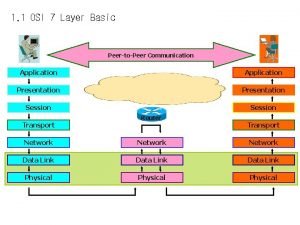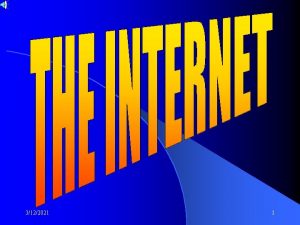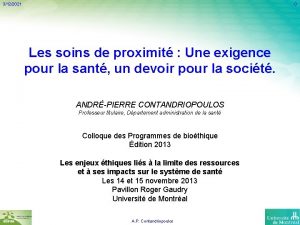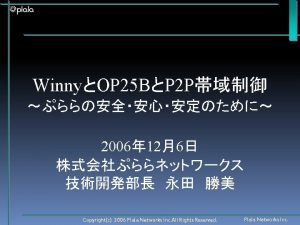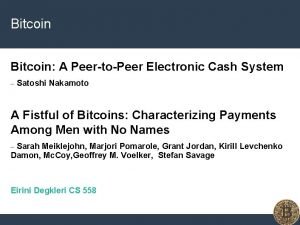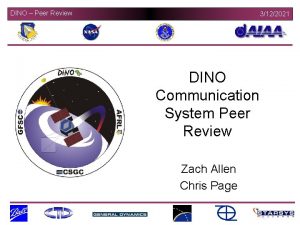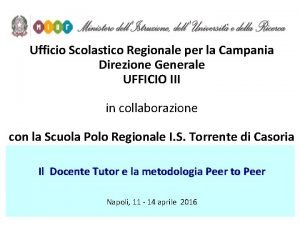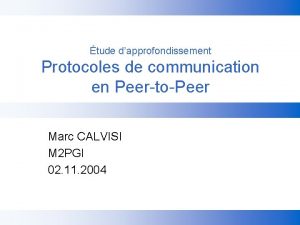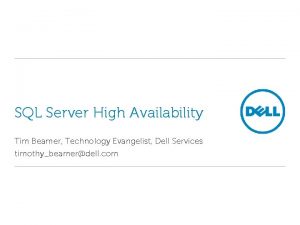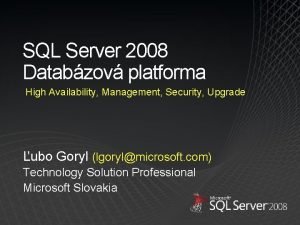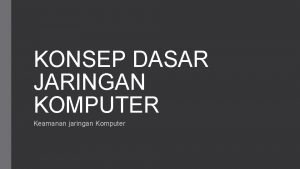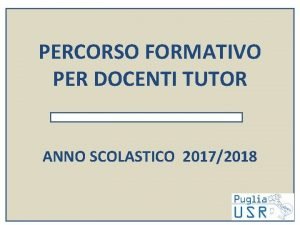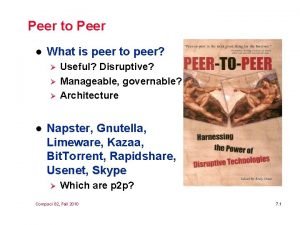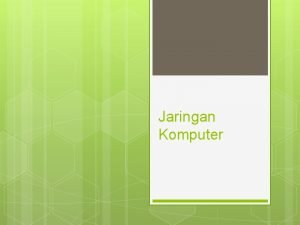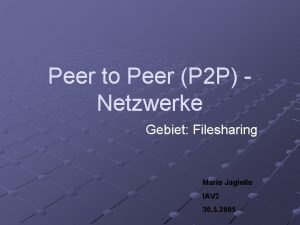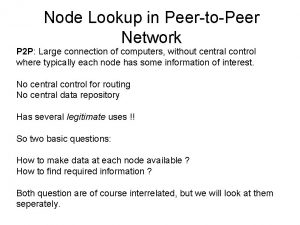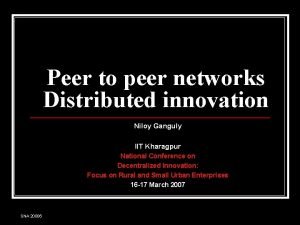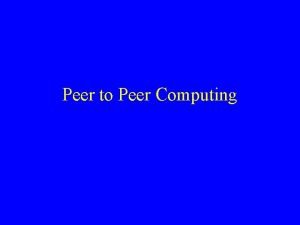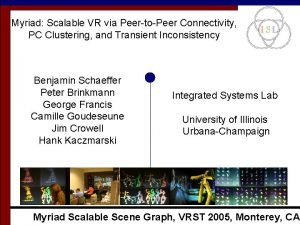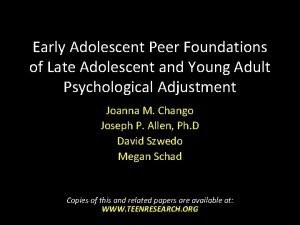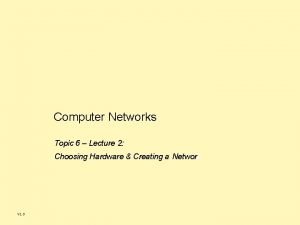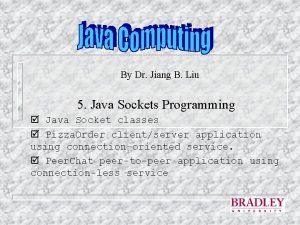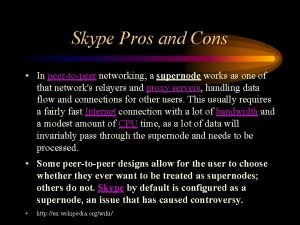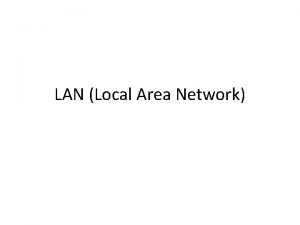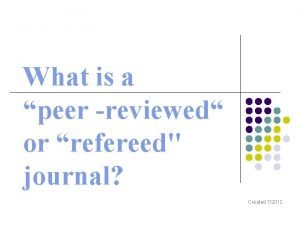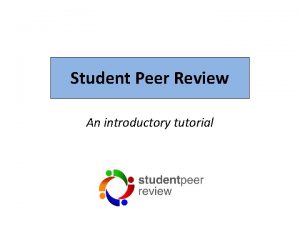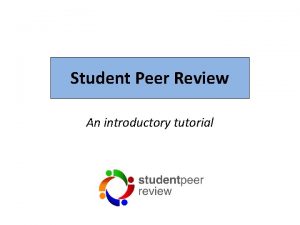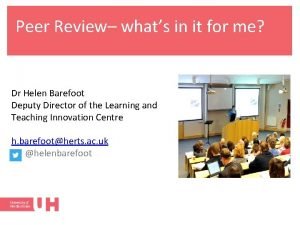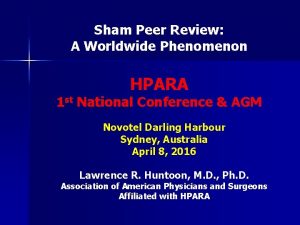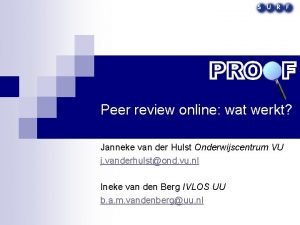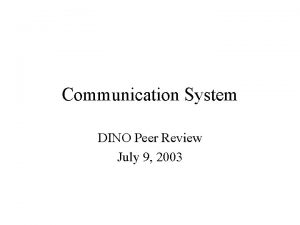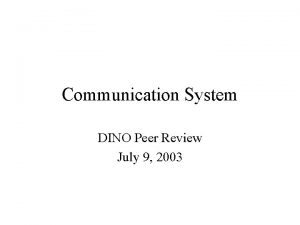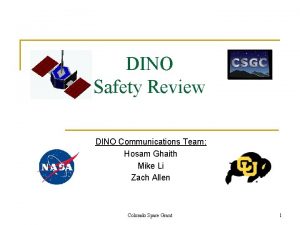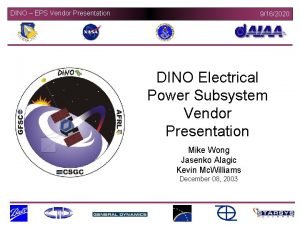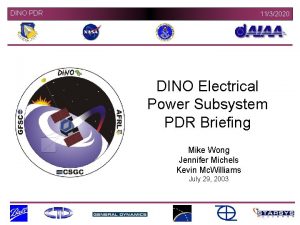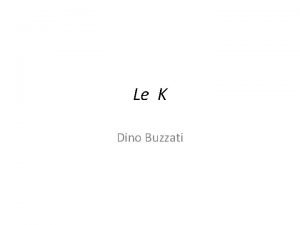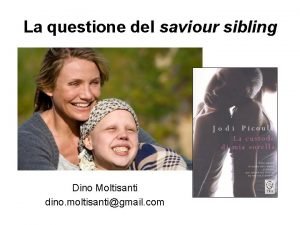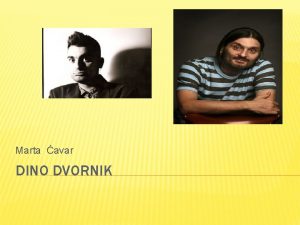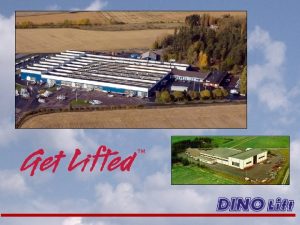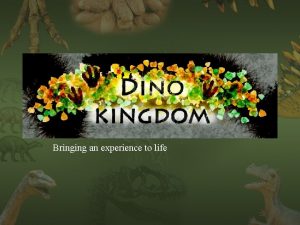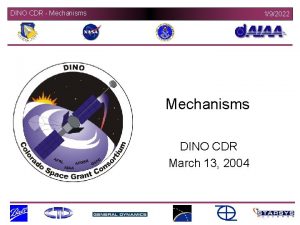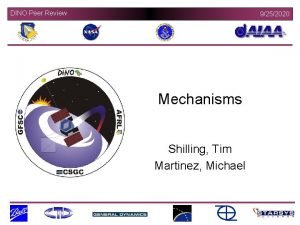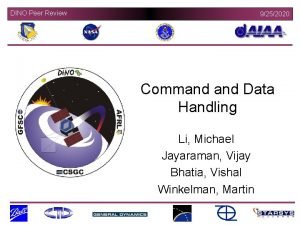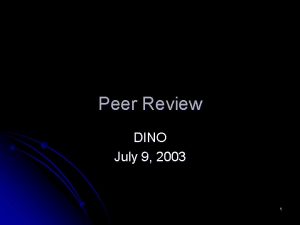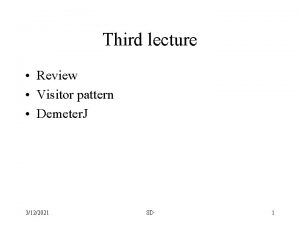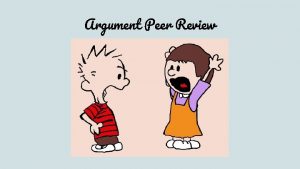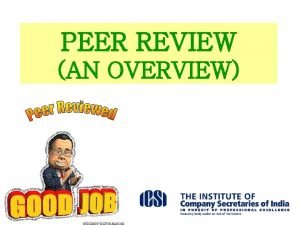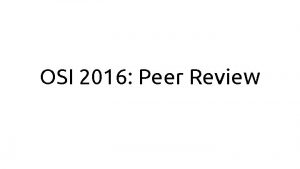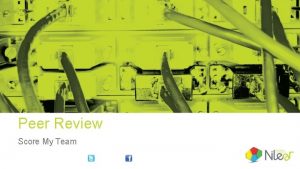DINO Peer Review 3122021 DINO Communication System Peer



































- Slides: 35

DINO – Peer Review 3/12/2021 DINO Communication System Peer Review Zach Allen Chris Page

DINO – Peer Review 3/12/2021 Purpose • Establish two-way communication link between satellite and ground station. – Link must allow transfer of map files from satellite to ground. – Must allow transmission of health and status data from satellite to ground. – Must allow the satellite radios and flight computer to receive command lines transmitted by ground station. Colorado Space Grant Consortium 2

DINO – Peer Review 3/12/2021 Requirements Imposed by other Subsystems • Data Rate: must be high enough to accommodate all data – 20 kbytes per topographical map – 255 bytes per Health and Status Packet – 5 kbytes per uploaded schedule • Antennas – Must be deployable by structures – No deployable ground plane allowed Colorado Space Grant Consortium 3

DINO – Peer Review 3/12/2021 Requirements on Power – Transmitter (Radio 1) • Transmit mode: 12 V at 1. 4 A (16. 8 W) • Idle mode: 12 V at 90 m. A (450 m. W) • Must have capability to be activated/deactivated by flight computer. – Receiver (Radio 2) • • – 5 V at 90 m. A (450 m. W) Must be active concurrently with flight computer External TNC (tentative): 12 V at 200 m. A (2. 4 W) • Must always be active when flight computer is active Colorado Space Grant Consortium 4

DINO – Peer Review 3/12/2021 Requirements on C+DH • Two RS-232 Serial Ports – 1 serial port dedicated to external TNC • 9600 baud, 8 data bits, no parity bit, 1 stop bit • Must have hardware flow control (CTS, RTS) – 1 serial port shared between radio 1 and radio 2 • Must be able to switch at any time between the two radios • 9600 baud, 8 data bits, no parity bit, 1 stop bit • Software flow control only Colorado Space Grant Consortium 5

DINO – Peer Review 3/12/2021 Requirements on Software • Set up Radio 1 (Transmitter) Parameters – Switch the shared serial port to Radio 1 immediately after Radio 1 is powered on (every time!) – Must program the following parameters into Radio 1: • • Transmit frequency (TBD, after FCC assigns the frequency) Transmit power (5 Watts) Colorado Space Grant Consortium 6

DINO – Peer Review 3/12/2021 Requirements on Software, Continued • Set up Radio 2 (Receiver) Parameters – Switch the shared serial port to Radio 2 immediately after Radio 2 is powered on (every time!) – Must program the following parameters into Radio 2: • Receive frequency (TBD, after FCC assigns the frequency) • Squelch Colorado Space Grant Consortium 7

DINO – Peer Review 3/12/2021 Requirements on Structures • Mass – Two Transceivers – 170 grams each – 2 x 170 grams = 340 grams total – External TNC – Still determining. Upper limit is 40 g. – Bent Dipole Antenna (transmit antenna) – Duck Antenna (receive antenna) – Approximately 2 feet of coax to feed the antennas Colorado Space Grant Consortium 8

DINO – Peer Review 3/12/2021 Requirements on Structures, Continued • Dimensions – Two Transceivers – 4. 9 x 2. 3 x 1. 2 inches each – Mounted together in one 3 CS-sized box (7. 25 x 4. 75 x 1 inch) – External TNC – Model still being determined – Upper Limit 6. 1 x 7. 3 x 1. 3 inch – Box arrangements TBD – Antennas – Deploy Bent Dipole – Deploy Duck Antenna Colorado Space Grant Consortium 9

DINO – Peer Review 3/12/2021 Subsystem Block Diagram 5 V line voltage 90 m. A 450 m. W (constant) RS-232 Serial 9, 600 bps (during setup only) Antenna Radio 2 Receiver Radio 1 Transmitter 12 V line voltage 1. 4 A 16. 8 W transmitting (450 m. W idle) Kenwood TH-D 7 Internal TNC RS-232 Serial 9, 600 bps (during setup only) External Terminal Node Controller (TNC) RS-232 Serial 9, 600 bps (constant) Legend Power Line Data Line • All Data lines use RS-232 Serial • Transmitter operates at 12 V • Receiver operates at 5 V. • External TNC: 12 V line, allows 9, 600 bps link to ground. • Internal TNC proven to be reliable at 1, 200 bps. 12 V line voltage 400 m. A, 4. 8 W (constant) Colorado Space Grant Consortium 10

DINO – Peer Review 3/12/2021 Design • Transceivers – Two Kenwood TH-D 7 radios • Radio 1: Downlink, approximately 436 MHz • Radio 2: Uplink, approximately 145 MHz • TNC still under consideration – Timewave PK-96 • Requires removing many electrolytic capacitors – Kantronics KPC 9612+ • Requires removing many electrolytic caps – Paccomm UP-9600 • Already surface mount • Heritage with Citizen Explorer Mission Colorado Space Grant Consortium 11

DINO – Peer Review 3/12/2021 Analysis: Power Requirements • Daytime Operation – Receiver: 0. 45 W (5 V, 90 m. A) always. – TNC: 2. 4 W (12 V, 200 m. A) always. – Transmitter: 16. 8 W (12 V, 1. 4 A) for approx. 8 minutes, otherwise same as Receiver (0. 45 W). • Nighttime Operation – Receiver: 0. 45 W (5 V, 90 m. A) always. – TNC: 2. 4 W (12 V, 200 m. A) always. – Transmitter: 16. 8 W (12 V, 1. 4 A) for approx. 4 seconds, otherwise same as Receiver (0. 45 W). • Safe Mode – Same as nighttime. Colorado Space Grant Consortium 12

DINO – Peer Review 3/12/2021 Analysis: Calculating Transmission Time • We need to find the transmission time in order to find the exact power requirements over the course of one day. • Time needed to send one packet: – 10 bits/byte * 256 bytes/packet 1200 bits/sec = 2. 133 sec/packet • Total transmission time (assuming 25 k. B per pass during daytime): – 2. 133 sec/packet * 25 k. B/pass 256 bytes/packet = 208. 3 sec/pass = ~ 3. 5 minutes (absolute minimum) – May be approx. twice the minimum (resending, errors, etc. ) – This is a realizable amount of time. Colorado Space Grant Consortium 13

DINO – Peer Review 3/12/2021 Antenna/Structure Considerations • • Fit on nadir plate without obstructing cameras Little room for placement inside satellite Deployment of antenna Antenna Structure – Cost – Weight – Material (no outgasing) Colorado Space Grant Consortium 14

DINO – Peer Review 3/12/2021 Antenna Considerations • Noise Factor and Loss • Maximum transmission distance • Radiation Pattern – Gain – Beam width – Efficiency • Link Budget – Carrier – to – Noise Ratio – Energy per bit – to – Noise Ratio (Available to Required) – Margin Colorado Space Grant Consortium 15

DINO – Peer Review 3/12/2021 Noise Factor and Loss • The receivers will determine the noise factor based on criteria like – Bandwidth – Sensitivity • Losses – – Free space loss Polarization loss Pointing, component, and implementation losses Atmospheric loss Colorado Space Grant Consortium 16

DINO – Peer Review 3/12/2021 Maximum Transmission Distance Calculations • Low orbit height from earth = 425 km • Maximum distance from base station antenna (horizon) = (with =5 o , slant angle) 1. 84 x 106 m – For =10 o 1. 39 x 106 m – For =15 o 0. 99 x 106 m • These distances play into our free space loss and ultimately our link budget Diagram Reference: Vincent L. Pisacane and Robert C. Moore, Eds. , Fundamentals of Space Systems. New York: Oxford University Press, 1994. Colorado Space Grant Consortium 17

DINO – Peer Review 3/12/2021 Up-link (Rubber Duck Antenna) • Targeted Frequency of 145 MHz – Wavelength of approx. 2. 1 m • Why chosen? – Ability to transmit high power and gain from base station – Heritage • Antenna Radiation Patterns – Gain – Beam Width • Link Budget Colorado Space Grant Consortium 18

DINO – Peer Review 3/12/2021 Up-Link (Rubber Duck Antenna): Radiation Patterns • Gain – To be on the safe side, gain was projected to be 0 d. B • Beam Width – Minimal beam width expected. Colorado Space Grant Consortium 19

DINO – Peer Review 3/12/2021 Up-Link (Rubber Duck Antenna): Link Budget Form courtesy of Dr. Stephen Horan, New Mexico State University. Colorado Space Grant Consortium 20

DINO – Peer Review 3/12/2021 Down Link • Targeted Frequency of 436 MHz – Wavelength of approx. 0. 7 m • Primary consideration – Bent Dipole • Helix design still in simulation • Next consideration is phased, 4 element antenna array Colorado Space Grant Consortium 21

DINO – Peer Review 3/12/2021 Down-Link (Bent Dipole Antenna) • Antenna Radiation Patterns – Gain – Beam Width • Link Budget • Simulations (NEC) – Design – Radiation Pattern – 3 D view of Radiation Pattern Colorado Space Grant Consortium 22

DINO – Peer Review 3/12/2021 Down-Link (Bent Dipole Antenna): Radiation Patterns • Gain – 6. 58 d. B (NEC Simulation 12 -8) • Transmitted Power – 36. 9 d. Bm (5 W) • Beam Width – 120 o – Filled requirement of 90 o Colorado Space Grant Consortium 23

DINO – Peer Review 3/12/2021 Down-Link (Bent Dipole Antenna): Link Budget Form courtesy of Dr. Stephen Horan, New Mexico State University. Colorado Space Grant Consortium 24

DINO – Peer Review 3/12/2021 Down-Link (Bent Dipole Antenna): Simulation Design Colorado Space Grant Consortium 25

DINO – Peer Review 3/12/2021 Down-Link (Bent Dipole Antenna): Simulation Radiation Pattern Colorado Space Grant Consortium 26

DINO – Peer Review 3/12/2021 Down-Link (Bent Dipole Antenna): 3 D View of Radiation Pattern 6. 58 0. 286 -14 Colorado Space Grant Consortium 27

DINO – Peer Review 3/12/2021 Antenna Deployment After Deployment Bent Dipole Monopole Note: placement of monopole will need to be simulated and tested for best results Before Deployment Colorado Space Grant Consortium 28

DINO – Peer Review 3/12/2021 Commands – After Antenna Deployment TNC power activated 1 Software switches serial port to Radio 2 power activated 2 3 4 Radio 1 power activated 5 Software programs Radio 2 Software switches serial port to Radio 1 6 Software programs Radio 1 7 Colorado Space Grant Consortium System Ready 29

DINO – Peer Review 3/12/2021 Antenna Test Plan • Testing to be done either at Ball Aerospace or CU Antenna Lab – Test for resonant frequency • By measuring reflection S parameters – Antenna Radiation Pattern Measurements • Gain • Beam width • Efficiency – Power transmitted to power received – Transfer files to and from spacecraft CDH system Colorado Space Grant Consortium 30

DINO – Peer Review 3/12/2021 Radio/TNC Test Plan • Incremental Testing is important to track bugs – Test TNC on bench first, connected directly to another TNC – Connect TNC to flight radios. Make transmissions of ASCII character strings. Verify properation. – Test to make sure that received packets get properly decoded and sent out of TNC serial port. – Install Radios and flight antenna prototypes into metal DINO model – Connect a computer running the flight software to the TNC in the DINO model – Attempt communication link between ground station and DINO flight model. Colorado Space Grant Consortium 31

DINO – Peer Review 3/12/2021 Parts list and Cost • Rubber duck – Bought through distributor – Cost of between $20 -$50 • Bent dipole – Metal selections considered • Copper: ~0. 68 pounds • Aluminum: ~0. 2 pounds – Estimated cost of $30 for each prototype • All design and manufacturing will be done by Space Grant Colorado Space Grant Consortium 32

DINO – Peer Review 3/12/2021 Parts List and Cost • Transmitter (Radio 1): $360. 00 • Receiver (Radio 2): $360. 00 • External TNC • Initial cost: $595. 00 • Custom Firmware: $80 Colorado Space Grant Consortium 33

DINO – Peer Review 3/12/2021 Issues and Concerns • Link Budget Issues – Need to verify noise figure and thermal noise for link budgets. – Need to verify link range • Bent Dipole Issues – Gain and beam width only simulated, prototype must be built and tested. – What will be the margin of error between angle needed to angle achieved when deployed Colorado Space Grant Consortium 34

DINO – Peer Review 3/12/2021 Issues and Concerns • External 9600 baud TNC interface still in question – Fall-back is 1200 baud Colorado Space Grant Consortium 35
 Peer-to-peer communication in osi model
Peer-to-peer communication in osi model Lll
Lll 3122021
3122021 3122021
3122021 3122021
3122021 Bitcoin: a peer-to-peer electronic cash system
Bitcoin: a peer-to-peer electronic cash system Dino box communication device
Dino box communication device Annotazioni sulla verifica effettuata peer to peer
Annotazioni sulla verifica effettuata peer to peer Peer-to-peer
Peer-to-peer Tim beamer
Tim beamer Peer to peer transactional replication
Peer to peer transactional replication Konsep dasar jaringan komputer
Konsep dasar jaringan komputer Registro peer to peer compilato
Registro peer to peer compilato Scheda osservazione tutor compilata
Scheda osservazione tutor compilata Relazione finale tutor tirocinio esempio
Relazione finale tutor tirocinio esempio Peer to peer l
Peer to peer l Peer to peer merupakan jenis jaringan… *
Peer to peer merupakan jenis jaringan… * Features of peer to peer network and client server network
Features of peer to peer network and client server network Programmazione e sviluppo condiviso peer to peer
Programmazione e sviluppo condiviso peer to peer Peer to p
Peer to p Node lookup in peer to peer network
Node lookup in peer to peer network Peer-to-peer o que é
Peer-to-peer o que é Peer to peer computing environment
Peer to peer computing environment Peer intervention program
Peer intervention program Peer-to-peer o que é
Peer-to-peer o que é Peer-to-peer o que é
Peer-to-peer o que é Peer to peer network hardware
Peer to peer network hardware Peer to peer chat application in java
Peer to peer chat application in java Pros and cons of using skype
Pros and cons of using skype Jaringan peer to peer diistilahkan dengan
Jaringan peer to peer diistilahkan dengan What is a refereed journal
What is a refereed journal How to write a peer review for college
How to write a peer review for college Peer review examples for students
Peer review examples for students Purpose of peer review
Purpose of peer review Sham peer review
Sham peer review Peer review voorbeeld
Peer review voorbeeld
